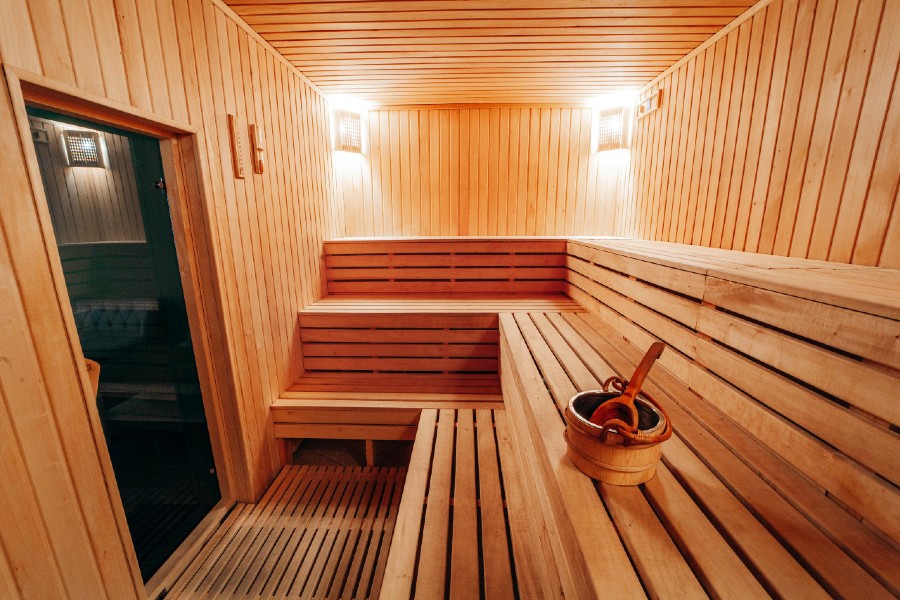Article updated September 2024.
Heat therapy has been used for centuries due to its ability to induce relaxation and promote muscle recovery. Various native cultures in Europe, Asia, and North and South America are known for practicing sweat bathing, which refers to various passive bathing strategies in high temperatures.
Regular exposure to heat can reduce inflammation and soft tissue injury, improve circulation and oxygenation to target muscles, enhance recovery, and promote relaxation and stress relief. Heat can also be beneficial in managing chronic pain and conditions that lead to reduced mobility.
Additionally, regular exposure to heat can activate the body’s defence mechanisms and create molecular changes by promoting the expression of genes and proteins that aid in muscle hypertrophy.
How does sauna assist in recovery?
Although passive heating can take many forms, including hot water bottles, heating pads, warm compresses, and microwave diathermy, saunas are one of the most accessible means of heat therapy.
As leaders in sauna construction, sauna materials, parts and accessories, SDS Australia have provided customers with sauna solutions for over 20 years. National Operations Manager, Ben Ridgway, says that both traditional and infrared saunas have their own benefits, but they work quite differently. “Traditional saunas heat the air around you, offering a full-body experience with higher temperatures and the added option of steam, which is great for relaxing muscles, improving circulation, and supporting respiratory health. Infrared saunas, on the other hand, use lower heat and work by warming your body directly. Traditional saunas have stood the test of time with well-researched health benefits.”
A traditional dry Finnish sauna is characterised by high temperatures ranging between 80-100°C with an average humidity of 10-20%. The minimum temperature required for a sauna to be effective is 65.5°C.
There are several ways that the use of sauna can assist in recovery, including;
The effects of sauna on muscle remodelling:
According to a study published by The Journal of Applied Physiology, the use of heat therapy, such as saunas and hot baths, elicits a rise in tissue temperature, initiating a series of physiological adjustments within the body. This cascade of responses encompasses hemodynamic (blood flow) and metabolic changes, ultimately activating pivotal signalling pathways involved in the remodelling of skeletal muscle.
Research has demonstrated that heat therapy has the capacity to enhance the production of heat shock proteins (HSPs) in skeletal muscle cells. These specialised proteins play a crucial role in minimising cellular damage and protein degradation induced by external stressors and injuries. Beyond their function as molecular chaperones that promote muscle growth, HSPs can also contribute to fortifying the immune system.
Passive heating has been found to augment protein content within muscle cells, increase the cross-sectional area of muscle fibres, and enhance muscle tone. Exposure to heat can also facilitate the formation and regeneration of muscle tissue, as well as the organisation of contractile units within muscle fibres.
This leads to an enhanced capacity of the muscle to generate force and swiftly change directions, thereby improving overall mobility and athletic performance. These compelling findings suggest that heat therapy holds significant potential as a valuable tool for the rehabilitation of individuals experiencing chronic disability and muscle weakness.

Sauna and muscle recovery
Delayed-onset muscle soreness (DOMS) is a common phenomenon that typically arises approximately 12 hours following exercise and can persist for several days. This type of discomfort encompasses various elements, such as muscle spasms, tension, swelling (referred to as oedema), increased stiffness, and resistance to stretching.
Scientific research has shed light on the effectiveness of applying heat immediately after exercise in mitigating pain and minimising the decline in muscle strength, consequently resulting in significantly reduced muscle damage. Heat is believed to exert an influence on the circulation and pressure within the blood vessels of the affected muscle, thereby aiding in the reduction of fluid accumulation (oedema) that restricts movement by inducing heightened tension.
Heat is thought to impact the function of the myotatic stretch reflex, an intrinsic mechanism of the muscular system that safeguards stability and diminishes the likelihood of injury. By diminishing nerve signals to the muscle fibres, heat induces muscle relaxation and subsequently lowers muscle spindle activity, culminating in a reduction of pain and stiffness typically associated with DOMS.
Therefore, when faced with the discomfort of DOMS subsequent to exercise, the application of heat, whether through the use of heat packs or by indulging in a warm bath, holds potential in reducing symptoms and expediting the recovery process.
The effects of regular sauna sessions on cardiovascular health:
The signalling pathways activated due to long-term exposure to heat can also promote capillary growth and hypertrophy in muscle cells, increase mitochondrial biogenesis, and improve glucose and insulin signalling. The improved glucose metabolism is thought to be due to repeated increases in glucose uptake in skeletal muscles after each heat therapy session.
According to a study conducted by Scoon et al., trained athletes who took part in post-exercise sauna sessions for three weeks experienced an improvement in plasma volume and a 36% increase in running time compared to the control group.
These findings highlight the potential of heat therapy to promote better vascular health and address conditions such as high blood pressure, atherosclerosis, and other cardiovascular diseases.
Additionally, regular sauna sessions can boost the immune system by increasing the activity of white blood cells, leading to a reduced risk of common cold infections.
Observational studies also suggest that frequent sauna sessions can lower inflammation and decrease the risk of acute and chronic diseases.

How long should you spend in the sauna for muscle recovery?
The optimal duration of sauna sessions for muscle recovery can vary depending on heat tolerance, the intensity of the heat, and individual preference. The American College of Sports Medicine suggests a maximum duration of 10 mins for beginners. However, the general rule is to not exceed 15-20 minutes per sauna session.
Additionally, individuals who suffer from cardiovascular or kidney diseases, are on certain medications or are pregnant should avoid using the sauna. Exposure to high temperatures for an extended period may lead to dehydration, heat exhaustion, or heart attacks.
Therefore, it’s vital to consult a medical or healthcare professional before using the sauna for its health benefits.
How many sauna sessions per week?
The North American Sauna Society recommends 2-3 sauna sessions a week for muscle recovery and rejuvenation. However, it’s crucial to consider factors such as the duration of each session, the intensity of the heat and humidity, and your current health status as well.
If you intend to use the sauna for its health benefits, make sure to drink plenty of fluids and listen to your body for signs of dehydration and discomfort. Additionally, it’s recommended that you wait at least 10 minutes after finishing a workout before entering the sauna.
Sauna and other forms of heat therapy are traditionally known for enhancing muscle recovery and promoting relaxation. However, research suggests that regular sauna sessions can also help on a molecular level by changing gene expression, improving the body’s ability to fight against inflammation and oxidative stress, and promoting energy production and muscle growth.
However, as with any other health intervention, the actual benefits of heat therapy will depend on individual factors such as health and medical history, age, frequency and duration of sauna sessions, and heat tolerance.
References
Skeletal muscle adaptations to heat therapy | Journal of Applied Physiology
The Efficacy of Sustained Heat Treatment on Delayed-Onset Muscle Soreness
The stretch reflex and the contributions of C David Marsden – PMC
Maintain health/fitness facility sauna, steam room, and whirlpool operating standards
Sauna Health Benefits: Are saunas healthy or harmful? – Harvard Health
Related Articles:

Can Sauna Therapy Help With Anxiety and Depression?
Millions of people deal with mental health issues like depression and anxiety every day. Many of them look for different ways to relieve stress, whether it’s from work or just feeling overwhelmed all the time. Among these, sauna therapy is becoming more popular due to the positive effects it may have on mental health. In

A Pilates and Recovery Franchise Opportunity For Investors
As demand for recovery modalities continue to rise and the popularity of Pilates keeps growing, entrepreneur David Altamura saw a gap in the health and wellness landscape. His successful studio, Wildsoul Wellness, is now available for franchising and opens up a real opportunity for potential investors and business owners to step into the Pilates and

TotalFusion Chermside Announces Exciting Expansion Plans
The team at What’s New in Fitness first visited TotalFusion Chermside back in 2018, when it was Australia’s newest studio concept – a heat-controlled, premium health and fitness facility built on the ethos of ‘movement as a way of life’ and a completely holistic offering that nurtures the mind and the body. The business has

Strategies for Attracting Gen Z to Your Fitness Business
When it comes to fitness, there are so many options out there – it’s a great thing for consumers as there’s bound to be a flavour everyone enjoys. This smorgasbord of choice, however, can make retention harder than ever for fitness business owners because there’s always a bright shiny object calling your members away. In

Be Mindful in May and Pause for a Cause
What if you could find more focus, clarity, and effectiveness in daily life by learning a 10-minute mindfulness technique and at the same time have a positive impact on the world? Join the Mindful in May movement next month and you can make it happen. What is Mindful in May? Mindful in May is a

Wello Works: Bringing Balance to Coworking Spaces Through Wellness
The popularity of coworking spaces has been trending upward for several years now. The same people who embraced the flexibility of working remotely in a post-pandemic world, are increasingly craving the social and productivity benefits that come with separating the work environment from the home. Fitness and wellness entrepreneur, Tony de Leede, has created a

A Close Look at the Benefits of Red Light Therapy
Red light therapy is one of the fastest growing wellness trends in the US and being offered as an extra for members in large fitness franchises such as Planet Fitness. But, is red light therapy really worth it? We took a look at the red light therapy benefits based on science to help you make

From Dream to Reality: How Blue Mountains Sauna Became a Resounding Success
This article was updated September 2024. With the benefits of sauna use ranging from cardiovascular improvements, faster recovery, mental health, and increased longevity, it’s not surprising that more and more Aussies are making it a part of their overall wellness routine. Blue Mountains Sauna opened in 2022 and has been a roaring success with heat-seekers

Building strength through community with The Real Body Movement
For many people, the gym is just somewhere to squeeze in that obligatory hour of exercise with a set of headphones in their ears or rushing in and out of a group class with barely a word spoken to their fellow attendees. For others, their gym is a genuine community – a place where connections
